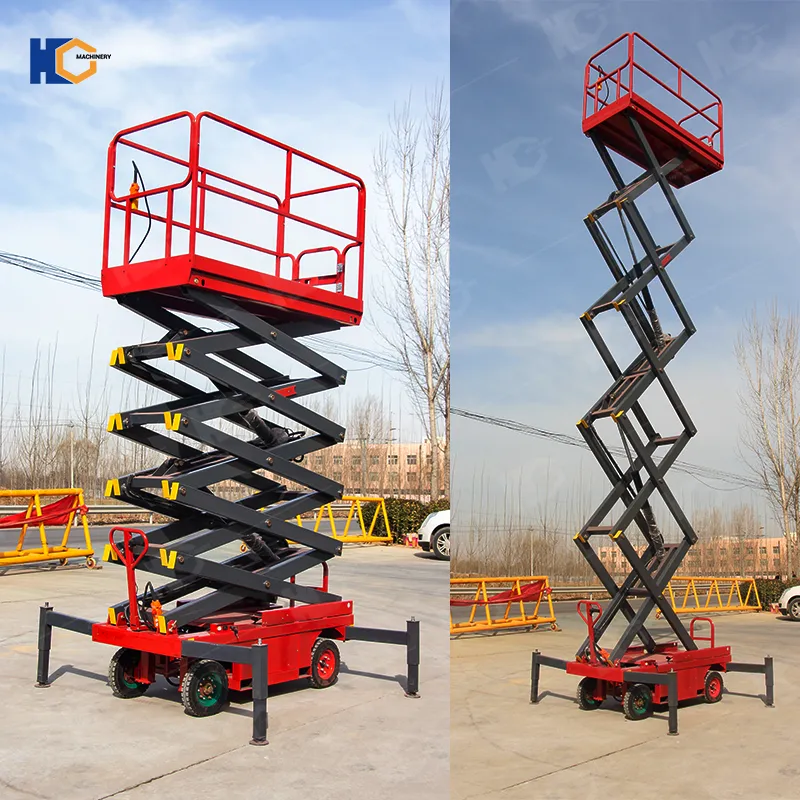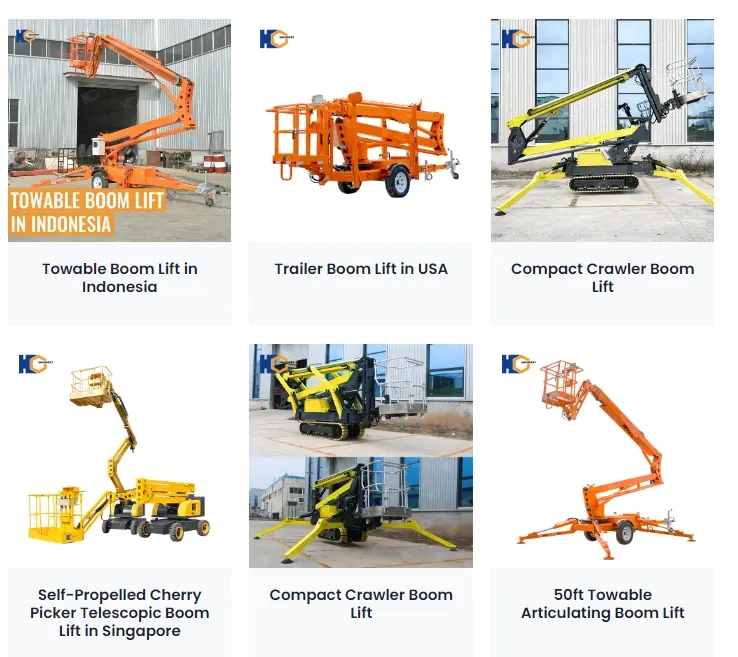While both are used for working at heights, they differ significantly in terms of functionality, applications, and pricing. This article provides a detailed comparison of these two machines and offers practical purchasing or rental recommendations to help you make the best decision.
I. Functional and Design Differences
1. Boom Lift (Articulated Aerial Work Platform)
Structural Features: Uses telescopic or articulated arms for horizontal and vertical extension, offering high flexibility.
Working Height: Typically 15-150 ft (4.5-45 m), suitable for higher and more complex work environments.
Mobility: Available in wheeled, tracked, and rough-terrain models, some with 360° rotation for tight spaces.
Load Capacity: Generally 500-1000 lbs (227-454 kg), accommodating 2-3 workers and tools.
Power Options: Diesel, electric, or hybrid; diesel preferred for outdoor use, electric for indoor.
Best for:
✔ Building facade construction
✔ Power line maintenance
✔ Large warehouse operations
✔ Film production and stage setup
2. Cherry Picker (Scissor Lift)
Structural Features: Uses a scissor mechanism for vertical lifting only (no horizontal extension).
Working Height: Typically 10-50 ft (3-15 m), ideal for medium-low height tasks.
Mobility: Larger base requires stable ground; less maneuverable.
Load Capacity: Generally 500-1200 lbs (227-544 kg), better for heavier loads.
Power Options: Electric (indoor) or diesel (outdoor).
Best for:
✔ Warehouse shelf access
✔ Mall lighting installation
✔ Indoor ceiling maintenance
✔ Short-term, fixed-position aerial work
560567.webp)
II. Price Comparison (Purchase vs. Rental)
1. Purchase Prices
| Equipment Type | New Price Range | Used Price Range |
|---|---|---|
| Boom Lift (Diesel) | $25,000−150,000+ | $10,000−80,000 |
| Boom Lift (Electric) | $20,000−100,000 | $8,000−50,000 |
| Cherry Picker (Electric) | $10,000−40,000 | $5,000−25,000 |
| Cherry Picker (Diesel) | $15,000−60,000 | $7,000−30,000 |
Notes:
Boom Lifts are more expensive due to their advanced flexibility.
Cherry Pickers are more budget-friendly for lower-height tasks.
2. Rental Prices (Daily/Weekly/Monthly)
| Equipment Type | Daily Rate | Weekly Rate | Monthly Rate |
|---|---|---|---|
| Boom Lift (Diesel) | $200−500 | $800−2,000 | $2,500−6,000 |
| Boom Lift (Electric) | $150−400 | $600−1,500 | $2,000−4,500 |
| Cherry Picker (Electric) | $100−300 | $400−1,000 | $1,200−2,500 |
| Cherry Picker (Diesel) | $120−350 | $500−1,200 | $1,500−3,000 |
Rental Tips:
Short-term (1-7 days) → Daily rental is cost-effective.
Mid-term (1-4 weeks) → Weekly/monthly packages save money.
Long-term (1+ month) → Consider buying used equipment.
III. How to Choose: Boom Lift or Cherry Picker?
Choose a Boom Lift if:
✅ You need horizontal reach (e.g., building exteriors).
✅ Working height exceeds 50 ft (15 m).
✅ Job site requires flexibility (e.g., utility repairs).
✅ Budget allows for long-term, high-frequency use.
Choose a Cherry Picker if:
✅ Only vertical lifting is needed (e.g., warehouse shelves).
✅ Working height is 10-50 ft (3-15 m).
✅ Ground is stable, no complex maneuvering required.
✅ Budget is limited, or usage is short-term.
699898.webp)
IV. Practical Recommendations
1. Purchasing Advice
High budget + long-term use → Buy a Boom Lift (diesel for outdoors).
Limited budget + medium-low height work → Buy a Cherry Picker (electric for indoors).
Used equipment: A smart choice for infrequent use (inspect before buying).
2. Rental Advice
Short-term projects (1-7 days) → Rent a Cherry Picker (low cost).
Complex aerial work → Rent a Boom Lift (better flexibility).
Long-term rental (1+ month) → Negotiate discounts or consider financing.
3. Safety & Maintenance
Operator training: OSHA certification is mandatory.
Regular inspections: Check hydraulics, structure, and safety locks.
Insurance: Ensure coverage (either purchased or provided by rental company).
V. Conclusion
Boom Lift → Best for complex, high-altitude jobs (higher cost, more features).
Cherry Picker → Best for simple, low-to-medium height tasks (budget-friendly).
Final Recommendations:
Construction & utility companies → Prioritize Boom Lifts.
Warehouses, malls, indoor work → Cherry Pickers are more economical.
Unsure? → Rent first to test before purchasing.
For professional Boom Lift and Cherry Picker solutions, contact JHNC Lift—a leading manufacturer in China with global after-sales support. Get competitive pricing and quality assurance today!

China Factory vs. Local Brand Procurement: A Strategic Guide
When sourcing equipment like Boom Lifts or Cherry Pickers, businesses face a key decision: buy directly from Chinese factories or purchase from local brands/distributors. Each option has trade-offs in cost, quality, lead time, and support. This analysis provides data-driven insights to optimize your procurement strategy.
I. Key Differences (China Factory vs. Local Brand)
| Factor | China Factory | Local Brand |
|---|---|---|
| Price | ✅ Lower (no middlemen) | ❌ Higher (brand markup) |
| Quality Control | ⚠️ Requires QC inspections | ✅ Consistent (brand standards) |
| Lead Time | ❌ Long (30-60 days + shipping) | ✅ Short (local stock) |
| After-Sales | ❌ Limited (self-managed) | ✅ Strong (brand support) |
| Customization | ✅ High flexibility | ❌ Standard models only |
| Payment Terms | ⚠️ Upfront (LC/TT) | ✅ Credit/installments |
| Logistics | ❌ Self-arranged (shipping/tax) | ✅ Included (DDP delivery) |
| Certifications | ⚠️ Self-verified (CE/OSHA) | ✅ Pre-certified |
II. When to Choose China Factory? When to Choose Local?
1. China Factory Procurement
✅ Pros
Cost savings: 20-50% cheaper than local (e.g., 30Kvs.50K for a Boom Lift).
Customization: Adjust specs (arm length, load capacity, power type).
Bulk discounts: Orders ≥10 units further reduce costs.
❌ Cons
Quality risks: Requires factory audits + third-party QC (e.g., SGS).
Delays: Shipping/customs may add 1-3 months.
Weak after-sales: DIY repairs or slow manufacturer response.
Best For
✔ Cost-sensitive buyers
✔ Non-standard requirements
✔ Large, recurring orders
2. Local Brand Procurement
✅ Pros
Fast delivery: Local stock = 1-2 weeks lead time.
Reliable support: Brand-backed maintenance (e.g., Genie, JLG).
Compliance: Pre-certified (CE/ANSI/OSHA).
❌ Cons
Higher price: 30-100% premium vs. China.
Less flexibility: Limited to existing models.
Best For
✔ Critical projects (minimize downtime)
✔ Urgent needs (e.g., short-term rentals)
✔ Strict regulatory markets (EU/US)

III. Cost Breakdown (Boom Lift Example)
| Cost Factor | China Factory | Local Brand |
|---|---|---|
| Unit Price | $30,000 | $50,000 |
| Shipping + Tax | $3,000 | $0 (included) |
| Annual Support | $2,000 (DIY) | $0 (warranty) |
| Year 1 Total | $35,000 | $50,000 |
| 5-Year Total | $45,000 | $50,000 |
Key Takeaway:
Short-term: China saves $15K upfront.
Long-term: Local brands may be cheaper (warranty coverage).
IV. Procurement Strategy
1. Buying from China? Ensure:
✔ QC process: Hire inspectors (e.g., SGS).
✔ Flexible timeline: Accept 2-3 month lead times.
✔ Large orders: ≥5 units to offset logistics.
⚠️ Risk Mitigation:
Demand CE/OSHA certs + client references.
Use Letters of Credit (LC), avoid full prepayment.
2. Buying Local? Optimize By:
✔ Negotiating volume discounts (e.g., 10-20% for annual contracts).
✔ Extending warranties (e.g., from 1 to 3 years).
V. Decision Flowchart

VI. Final Recommendations
Maximize savings + accept risk → China factory (experienced buyers).
Prioritize reliability → Local brand (critical operations).
Hybrid approach:
Source large equipment from China for cost.
Use local suppliers for spare parts/service.
First-time buyers? Start with a local brand to build trust, then explore China for scaling.

JJHNC Lift is a professional manufacturer of Boom Lift and Cherry Picker in China. We have our own Boom Lift and Cherry Picker design and manufacturing factories to help our customers achieve maximum profit and quality assurance. A globally comprehensive after-sales service system can solve your worries. If you are choosing products such as Boom Lift, Cherry Picker, etc., please contact us for competitive prices.
213.webp)
322.webp)
222.webp)
740.webp)